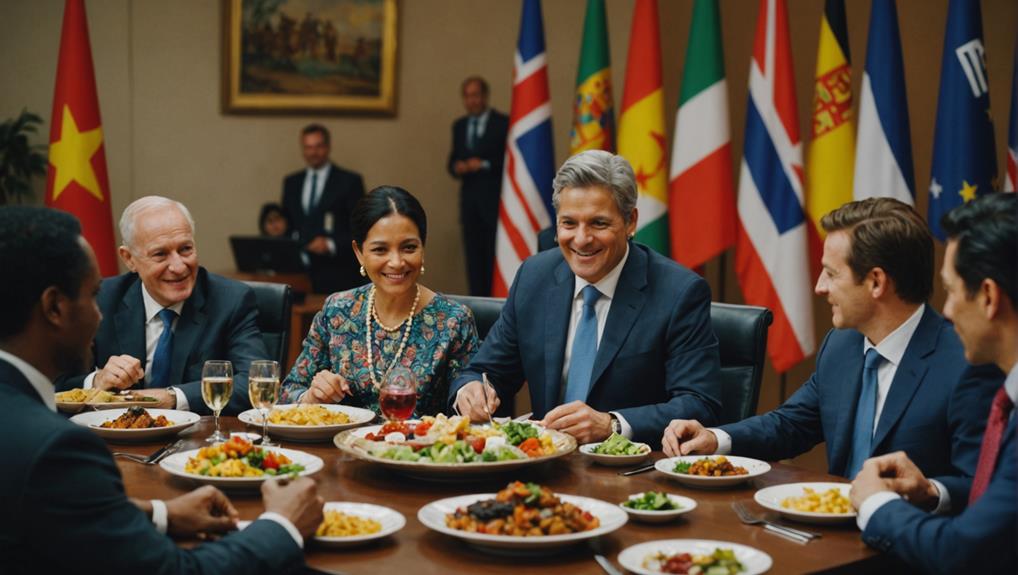Identifying and Addressing Cultural Differences in Post-Merger Integration

Identifying and addressing cultural differences in post-merger integration is crucial for a successful amalgamation. We start by analyzing organizational cultures, focusing on fundamental principles, communication norms, and leadership approaches.
Assessing cultural compatibility involves comparing decision-making processes and workplace standards. Involving leadership ensures alignment, while transparent communication fosters trust. Establishing a shared vision, supported by collaborative efforts across functions, promotes unity.
Forming cross-cultural teams and commemorating cultural milestones enhances mutual understanding. Continuously monitoring and adjusting the integration process aids in effectively managing cultural conflicts. For a detailed exploration of strategies, seeking consultations on these aspects can significantly enhance merger outcomes.
Key Takeaways
- Analyze the cultural values and fundamental beliefs to assess the compatibility between the merging organizations.
- Evaluate the communication styles and establish common platforms to enhance clear and cohesive interactions.
- Compare the decision-making processes to harmonize authoritative and collaborative approaches.
- Identify and align the leadership styles to form a cohesive and efficient leadership team.
- Track the integration progress through Key Performance Indicators (KPIs) and employee feedback to address any emerging cultural discrepancies.
Understanding Organizational Cultures
Understanding organizational cultures is crucial because they define a company's vision, values, and management practices. These cultural elements play a significant role in shaping the success or failure of mergers and acquisitions (M&A).
When companies combine, it isn't just about merging teams but also about aligning decision-making styles, establishing a unified direction, and preventing culture clashes that can hinder progress.
Decision-making styles are intrinsic to organizational cultures, reflecting how companies function and make crucial decisions. Integrating these styles requires a careful and balanced approach that considers both similarities and differences.
It's essential to focus on measurable cultural aspects such as communication norms, leadership approaches, and levels of employee engagement. These quantifiable factors offer a practical framework for evaluating cultural compatibility and guiding integration strategies.
Culture clashes often arise when merging entities face a lack of alignment. These clashes can result in misunderstandings, lower morale, and, ultimately, unsuccessful mergers.
To mitigate these challenges, leaders must prioritize creating an inclusive environment and promoting open communication. By fostering a culture where diverse viewpoints are valued, organizations can encourage innovation and ensure a smooth transition post-merger.
Successfully understanding and integrating organizational cultures sets the stage for a seamless and productive merger. By recognizing the importance of cultural alignment and actively addressing potential challenges, companies can enhance their chances of achieving successful post-merger integration and driving long-term growth.
Assessing Cultural Compatibility
To evaluate cultural compatibility effectively, we must focus on three key areas:
shared values,**
leadership styles**, and
communication practices.
By analyzing these elements, we can pinpoint potential clashes in culture early on and devise strategies to mitigate them.
This approach ensures that we integrate cultural considerations into our change management processes, increasing the likelihood of a successful merger.
Shared Values Assessment
Assessing shared values is crucial for evaluating the cultural fit of merging organizations. This assessment helps identify similarities, differences, and potential conflict areas between the merging entities, ensuring a seamless integration post-merger.
By focusing on shared values, we can measure how well the entities align in core values, communication styles, decision-making processes, and organizational structures.
Evaluating these key aspects enables the creation of a comprehensive cultural assessment that informs the development of an integration roadmap. This roadmap acknowledges the strengths of each organization while effectively bridging cultural gaps.
This process ensures the integration blends the best elements from both cultures, creating an environment conducive to innovation.
Leadership Style Alignment
Assessing leadership style alignment is crucial in determining cultural compatibility during the post-merger integration phase. Understanding how leadership styles impact decision-making processes and organizational structures is key when two entities come together.
Diverse leadership approaches can either mesh well together or create conflicts, influencing the decision-making and implementation processes within the newly formed organization.
Ensuring that leadership styles are in sync helps in forming a united leadership team capable of effectively steering through the integration challenges. This entails examining how leaders communicate, delegate responsibilities, and handle conflicts.
For example, if one organization values teamwork in decision-making while the other follows a more authoritative approach, aligning these styles becomes essential to prevent friction and ensure seamless operations.
A comprehensive evaluation of leadership styles allows for the early identification of potential conflict areas. Recognizing disparities in conflict resolution strategies enables the proactive mitigation of issues before they escalate, fostering a smoother integration process.
Ultimately, addressing these differences in leadership styles not only enhances the merger's success but also sets the stage for innovative growth opportunities.
Communication Practices Evaluation
Understanding communication practices is crucial for evaluating cultural compatibility in post-merger integration. It's essential to assess the differences in communication styles between the merging companies to identify potential cultural barriers that could impede integration efforts. By examining these practices, we can uncover how information flows within each organization and align our communication strategies to promote a more cohesive culture.
Pinpointing the preferred modes of communication in both companies enables us to effectively bridge any gaps. For example, if one company leans towards direct emails while the other leans towards collaborative meetings, recognizing and adapting to these differences is crucial for cultural alignment. Evaluating the efficacy of current communication strategies helps us identify areas for improvement to enhance overall cultural compatibility.
Identifying Key Cultural Differences

When identifying significant cultural differences, let's first focus on examining variations in communication styles. Understanding how teams from different backgrounds communicate can greatly impact the success of post-merger integration efforts. By recognizing these differences early on, we can proactively address potential barriers to collaboration and ensure effective communication channels are established.
Next, it's crucial to analyze decision-making processes within the merging organizations. Balancing authority and consensus in decision-making can be a key challenge during post-merger integration. By gaining insight into how each organization approaches decision-making, we can navigate potential conflicts and find common ground that aligns with the new entity's goals.
Lastly, comparing workplace norms is essential for understanding cultural expectations around behavior, work hours, and employee engagement. By recognizing and respecting these differences, we can create a harmonious work environment that promotes cross-cultural understanding and collaboration. This will help mitigate potential friction points and foster a cohesive post-merger integration process.
Communication Style Variations
Understanding the diverse communication styles within different cultures is crucial for successful post-merger integration. By recognizing and adapting to these variations, we can avoid misunderstandings and conflicts, thus promoting effective collaboration and cultural alignment. These variations in communication styles can significantly impact decision-making processes, team dynamics, and overall employee engagement.
It is important to be mindful of key cultural differences in communication styles when navigating the challenges of post-merger integration. Cultures vary in their preference for direct or indirect communication, with some valuing explicitness while others rely on contextual cues. Additionally, some cultures are high-context, communicating implicitly and relying on shared understanding, while others are low-context, emphasizing clarity and explicit information.
Formality in communication also varies across cultures, with some favoring structured, hierarchical interactions while others prefer informal, egalitarian approaches. Understanding these differences can help in establishing effective communication channels within the merged entities.
Moreover, recognizing feedback preferences across cultures is essential, as comfort levels with giving and receiving feedback can impact employee morale and engagement significantly.
Decision-Making Processes
Expanding on our grasp of various communication styles, it's crucial to acknowledge how cultural disparities influence decision-making processes during post-merger scenarios. Decision-making methods are deeply embedded in the corporate culture and can significantly impact the success of post-merger integration. Failure to address these differences can lead to challenges in aligning processes and reaching agreements.
Efficient and prompt decision-making plays a pivotal role in ensuring a smooth integration process. To achieve this, it's imperative to understand the decision-makers in both organizations and comprehend their distinct styles. This entails identifying key decision-makers and understanding whether they prefer hierarchical or collaborative decision-making approaches.
Building a consensus becomes a vital component of this process. It's essential to actively work towards aligning processes to ensure mutual understanding. Clearly communicating expectations, deadlines, and decision-making protocols is essential. By establishing and adhering to these protocols, we can streamline processes and prevent unnecessary delays or misinterpretations.
In essence, grasping the decision-makers and their cultural contexts enables us to navigate the intricate landscape of post-merger integration more effectively. This proactive stance not only reduces conflicts but also cultivates a more innovative and cooperative environment going forward.
Workplace Norms Comparison
When comparing workplace norms between merging companies, we often uncover fundamental cultural differences that must be addressed for a successful integration. A thorough analysis of communication styles, decision-making processes, and organizational structures can reveal potential conflicts that may arise.
To ensure a seamless post-merger integration, it's essential to focus on the following aspects:
- Communication Styles: Understanding how each company communicates internally and externally, whether through formal channels or informal discussions.
- Core Values: Contrasting the fundamental principles and beliefs that guide employee behavior and company policies to determine alignment or divergence.
- Employee Behaviors: Observing daily interactions and activities to grasp the expectations and norms prevalent in each organization.
- Decision-Making Processes: Evaluating how decisions are reached and the level of involvement from different hierarchical levels, be it top-down or collaborative approaches.
A detailed examination of these factors enables the creation of a comprehensive roadmap for effectively integrating cultures, bridging gaps, and nurturing a unified work environment.
Addressing these critical cultural differences during the workplace norms comparison phase can facilitate a smoother integration and pave the way for a successful post-merger collaboration, allowing both companies to innovate and prosper together.
Effective Communication Strategies
To bridge cultural gaps after a merger, clear and transparent communication is essential. Effective communication plays a crucial role in our integration efforts, helping us grasp cultural differences and fostering unity. By outlining shared goals and principles, we ensure that both merging parties feel valued and in sync.
Using various communication channels such as town halls, newsletters, and digital platforms, we can reach all employees, promoting inclusivity and trust. These tools enable us to share updates, mark achievements, and promptly address any concerns. Actively listening to feedback is vital; by carefully considering input and taking action, we create an environment conducive to cultural blending.
Creating a mutual vision and values, with contributions from both merging companies, boosts engagement and alignment. This joint approach guarantees that everyone feels like a part of the new corporate identity, minimizing resistance and misunderstandings.
In a dynamic business environment, our communication strategy must be flexible and responsive. By emphasizing transparency and inclusivity, we can effectively navigate the complexities of post-merger integration, ensuring a smoother transition and a more cohesive organizational culture. This approach sets the foundation for long-term success and expansion.
Engaging Leadership in Integration

Engaged leadership plays a pivotal role in merging and integrating cultures successfully after a merger or acquisition. Leadership involvement is key to aligning the vision and values of the combined entity, a crucial aspect of cultural integration.
When leaders are actively engaged, they set the tone for the entire organization, creating an environment conducive to effective communication, trust-building, and transparency. This, in turn, lays the foundation for a harmonious post-merger culture.
The support of top management is essential in driving employee engagement and commitment to the integration process. Visible leadership engagement sends a strong signal that the integration is a top priority, motivating employees and emphasizing the importance of cultural alignment in the new organization.
To illustrate our strategy, consider these key actions:
- Open and honest communication: Leaders should communicate regularly and transparently to establish trust.
- Active leadership participation: Leaders need to be present and engaged throughout the integration.
- Endorsement of cultural initiatives: Management should support efforts to align and merge cultures.
- Employee engagement programs: Implement strategies that encourage employees to actively contribute to the integration process.
Building a Unified Vision
Creating a unified vision is pivotal for guiding the merged organization towards a common objective and ensuring sustained success. To achieve this, it is essential to have leadership alignment and a shared vision that resonates with all members of the organization. By involving representatives from both merging companies, we can establish common values, expectations, and performance metrics, thereby promoting alignment within the new entity.
Cross-functional collaboration and collaborative workshops play a crucial role in fostering understanding and cooperation among teams with diverse cultural backgrounds. These activities help in breaking down barriers and uniting the teams into a cohesive whole. Additionally, implementing a transparent communication strategy is vital to ensure that everyone is well-informed and working towards the same goals.
Here's a simple breakdown:
| Aspect | Action | Benefit |
|---|---|---|
| Leadership Alignment | Engage key leaders early | Unified direction |
| Shared Vision | Define mutual goals | Collective motivation |
| Cross-Functional Collaboration | Conduct joint workshops | Enhanced team integration |
| Transparent Communication | Develop clear messages | Consistent understanding |
Creating Cross-Cultural Teams

To strengthen the shared vision, forming cross-cultural teams is a strategic way to connect employees from different merging organizations. These teams play a vital role in promoting collaboration and understanding, essential for a successful integration post-merger. By bringing together individuals from various cultural backgrounds, we create an environment conducive to building relationships.
Establishing cross-cultural teams can be done through different approaches to ensure inclusivity and value for all team members. Conducting joint workshops allows team members to exchange experiences and learn from one another, fostering a culture of mutual growth.
Mentorship programs can offer guidance and support that transcends cultural boundaries. Job rotations provide employees with the opportunity to gain insights from different perspectives, enhancing their awareness of the diverse cultural fabric within the organization. Informal interactions within these teams help cultivate cooperation and shared objectives, fostering a sense of unity.
Effective strategies for creating cross-cultural teams include:
- Joint Workshops: Facilitate collaborative learning and idea exchange.
- Mentorship Programs: Provide cross-cultural guidance and support.
- Job Rotations: Offer immersive experiences in varied roles.
- Informal Interactions: Encourage meaningful connections through casual interactions.
Monitoring and Adapting Integration
By monitoring the integration process closely, we can swiftly identify any clashes in culture and make essential adjustments to nurture a more cohesive environment. Monitoring progress is crucial as it allows us to pinpoint areas where our integration efforts may be faltering and need recalibration.
By regularly tracking key performance indicators (KPIs), we gain insights into the effectiveness of our strategies and can adapt them based on real-time data.
Employee feedback plays a pivotal role in this process. Conducting surveys and organizing focus groups provide us with invaluable information directly from the source. Their perspectives help us understand the nuances of cultural alignment and highlight areas needing immediate attention.
This feedback loop ensures our strategies remain flexible and responsive, addressing cultural differences effectively.
Adapting strategies based on this continuous feedback allows us to fine-tune our approach, ensuring that our integration efforts aren't only efficient but also innovative. Flexibility in our methods is essential for fostering a harmonious post-merger environment.
Celebrating Cultural Milestones

Adapting our strategies based on feedback, celebrating cultural milestones serves as a powerful tool to promote unity and inclusivity in our newly merged organization. Recognizing and appreciating the diverse cultural backgrounds within our team not only helps bridge gaps but also fosters a sense of belonging among employees. By honoring these milestones, we demonstrate profound respect for different traditions and values, which is crucial for building a cohesive work environment.
Celebrating cultural milestones energizes our team, significantly boosting employee engagement. It goes beyond mere acknowledgment; it showcases our dedication to diversity and inclusivity. When employees witness their culture being celebrated and valued, they feel appreciated and respected, leading to increased morale and loyalty. This practice strengthens the unity of our team, creating an atmosphere where everyone feels included and valued.
To effectively integrate these celebrations into our corporate culture, we should consider:
- Incorporating diverse cultural holidays into our annual calendar: This ensures the recognition of various traditions.
- Hosting cultural exchange events: These events promote understanding and appreciation among team members.
- Establishing a cultural recognition program: Highlighting contributions from various cultural backgrounds.
- Encouraging employee-led cultural activities: Empowering employees to share their cultural heritage.
Frequently Asked Questions
How Can You Overcome Cultural Differences in Mergers and Acquisitions?
Overcoming cultural disparities in mergers and acquisitions requires a multifaceted approach. Implementing diversity training, fostering robust employee engagement, facilitating effective conflict resolution, and ensuring leadership alignment are essential strategies. By conducting comprehensive cultural assessments, organizations can ensure alignment and innovation, creating a cohesive and forward-thinking entity post-merger.
What Are the Four C's of Post-Merger Integration?
The Four C's of post-merger integration encompass Communication, Collaboration, Cultural Alignment, and Change Management. Success in merging companies relies on thorough planning, ensuring leadership alignment, implementing a robust communication strategy, fostering active employee engagement, and executing effective change management.
These key factors play a crucial role in navigating the complexities that arise during the integration process. By prioritizing communication, fostering collaboration, aligning cultures, and managing change effectively, organizations can enhance their chances of achieving a successful merger and maximizing the benefits of the integration.
How to Integrate Cultures in a Merger?
Integrating cultures in a merger is akin to blending colors seamlessly. By aligning leadership, creating a shared vision, and implementing cultural workshops, cross-training sessions, and employee surveys, organizations can ensure a harmonious and innovative environment where all individuals can thrive.
Merging cultures is a complex process that requires careful planning and execution. It involves bringing together diverse backgrounds, values, and ways of working to create a cohesive and unified culture. By engaging employees in the integration process and providing opportunities for open communication and collaboration, organizations can foster a sense of unity and shared purpose.
Cultural integration in mergers is not just about blending different cultures together, but also about creating a new, unique culture that draws on the strengths of each organization. By recognizing and celebrating the differences and similarities between the merging companies, organizations can create a culture that is inclusive, diverse, and innovative.
What Would You Do to Overcome the Language and Cultural Difficulties After Merger?
To overcome language and cultural challenges post-merger, we will implement language training, cultural workshops, and hire bilingual staff. Additionally, integration consultants will be brought in to facilitate the process. Cross-cultural mentoring will ensure effective communication and mutual understanding, fostering innovation in the merged entity. These strategies have been proven effective in previous mergers and acquisitions, leading to successful integration and enhanced collaboration among diverse teams.
Conclusion
We've successfully navigated the complexities of post-merger integration, emphasizing the significance of cultural congruence. Through a thorough assessment of cultural fit, identification of critical differences, and promotion of clear communication, we can seamlessly bridge cultural divides.
Active involvement of leadership and the cultivation of a shared vision are crucial, as is the formation of multicultural teams. Monitoring advancements and commemorating cultural milestones ensure long-term success.
Interestingly, when we invest in comprehending and valuing each other's cultural backgrounds, the merger transcends mere success—it becomes transformative.
